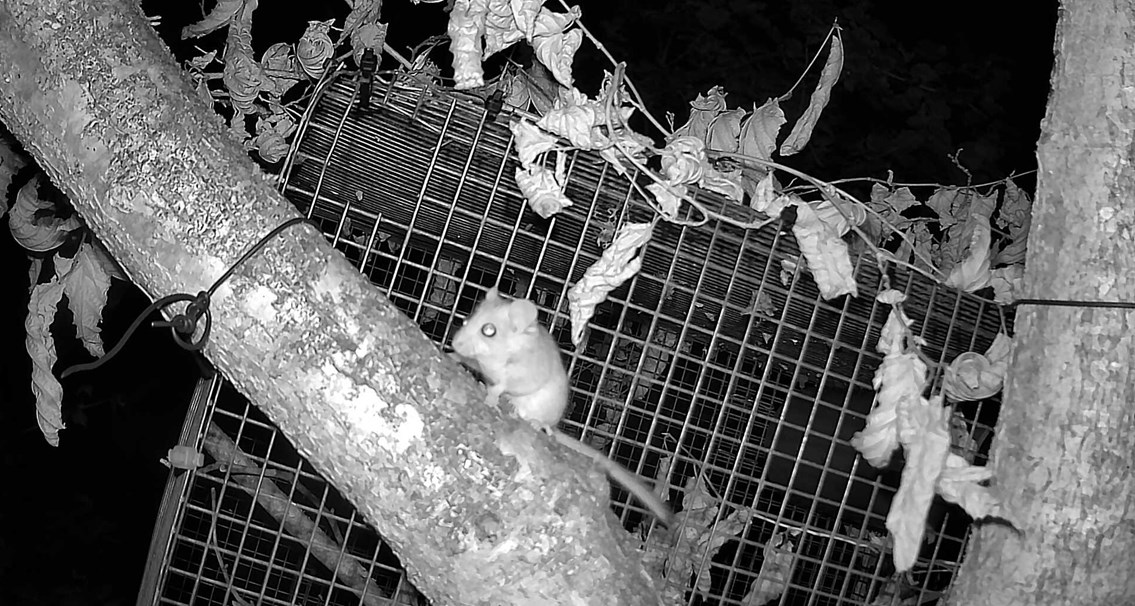Monday 11 Dec 2023
Smile for the camera! AI and machine learning help railway’s cutest neighbours, thanks to Network Rail, ZSL and Google Cloud partnership
- Region & Route:
- National
Network Rail’s railway land is home to a variety of plant and animal species, few of which are as cute as these dormice. The railway company’s Southern region is working in partnership with ZSL (Zoological Society of London) to explore innovative ways to better understand and monitor what species are living along the railway.
ZSL and Network Rail’s Southern region have been working together with Google to develop methods for monitoring these rare species on lineside land, which is often difficult to access. In partnership with People’s Trust for Endangered Species (PTES) – a leading wildlife charity which works to conserve dormice and other species - equipment was deployed in woodland near Calke Abbey in Derbyshire, cared for by the National Trust and where PTES’ annual dormouse reintroduction took place in June. Many images, videos and acoustic recordings were gathered, which will be used to develop new AI and machine learning algorithms for identifying dormouse presence remotely.
The data is stored and analysed on GoogleCloud, offering the potential for Network Rail to make significant savings of time and money compared with manually checking dormouse nest boxes for their presence throughout the season.
Camera traps and audio sensors have been used in various locations in London and the South East, with a current focus on a site near Cowden in Kent, known to harbour dormice. Hazel dormice are known to live along the edge of certain stretches of railway, mainly in the south of the country and along the Welsh border. Despite being a protected species they are listed as vulnerable to extinction on the IUCN Red List for Britain’s Mammals and are even thought to have declined by 70% since 2000, according to PTES’ State of Britain’s Dormice report published last month.
Network Rail ecologist Aline Gomes said: “Understanding the plant and animal life around our railway plays a big part in helping us manage our railway sustainably. Our regional ecology team wanted to find innovative ways of monitoring the wildlife on our lineside while maintaining a safe distance, and working with ZSL has allowed us to achieve that. The knowledge we are gaining is already improving the way we manage our land to benefit the different species that live along our railway, including dormice.
“The railway can provide a great habitat for dormice and by gaining a deeper understanding of the species, we can help them by improving how and when we manage the lineside habitat to contribute towards the conservation of the species.”
ZSL’s Project Manager Rachael Kemp said: “Unlocking the power of cutting-edge technology, our remote, automated methods provide an exciting, cost-efficient opportunity to study dormice living near railways. We are using images, videos and audio files of dormice collected at Calke Abbey and Cowden to train machine learning algorithms to help Network Rail understand which nest boxes along the tracks are being used by this beloved mammal and easily monitor them over time. This will help Network Rail understand how lineside maintenance and conservation strategies are affecting local populations”.
Network Rail’s biodiversity strategy manager, Dr Neil Strong, said: “Managing our railway lineside is important not just because we have to keep trains safe but also because those linesides provide wildlife corridors for species such as dormice, which would struggle to move between habitats otherwise.
“We have to manage them though – it’s not about letting them grow wild. Trees can fall in front of trains and grow in front of signals, so we work to cut back those where we have to, and make the right habitat, ideally away from the tracks, to give good cover for creatures who need it.”
Google Cloud’s executive sponsor Omer Mahmood said: “As part of our ongoing commitment to help our customers use Google Cloud’s AI and ML to drive important climate and conservation efforts, it has been our privilege to be a key technology partner with ZSL and Network Rail on this project.
“We look forward to new opportunities for collaboration, enabling Network Rail to meet their ambitions for a net gain in lineside biodiversity, by improving the efficiency of their data pipelines and monitoring at scale, across their rail network in the years to come”.
For more information on how Network Rail is using its land to improve biodiversity, visit: https://www.networkrail.co.uk/sustainability/biodiversity-on-britains-railway
To find out more about hazel dormice, visit www.ptes.org/dormice
Notes to Editors
Interviews with Dr Neil Strong (Network Rail biodiversity manager) available on request.
Contact information
Passengers / community members
Network Rail national helpline
03457 11 41 41
Latest travel advice
Please visit National Rail Enquiries
Journalists
Network Rail press office - Chris Denham
Operational Communications Manager
020 3357 7969
07515 626530
chris.denham@networkrail.co.uk
About Network Rail
We own, operate and develop Britain's railway infrastructure; that's 20,000 miles of track, 30,000 bridges, tunnels and viaducts and the thousands of signals, level crossings and stations. We run 20 of the UK's largest stations while all the others, over 2,500, are run by the country's train operating companies.
Usually, there are almost five million journeys made in the UK and over 600 freight trains run on the network. People depend on Britain's railway for their daily commute, to visit friends and loved ones and to get them home safe every day. Our role is to deliver a safe and reliable railway, so we carefully manage and deliver thousands of projects every year that form part of the multi-billion pound Railway Upgrade Plan, to grow and expand the nation's railway network to respond to the tremendous growth and demand the railway has experienced - a doubling of passenger journeys over the past 20 years.
Follow us on Twitter: @networkrail
Visit our online newsroom: www.networkrailmediacentre.co.uk

